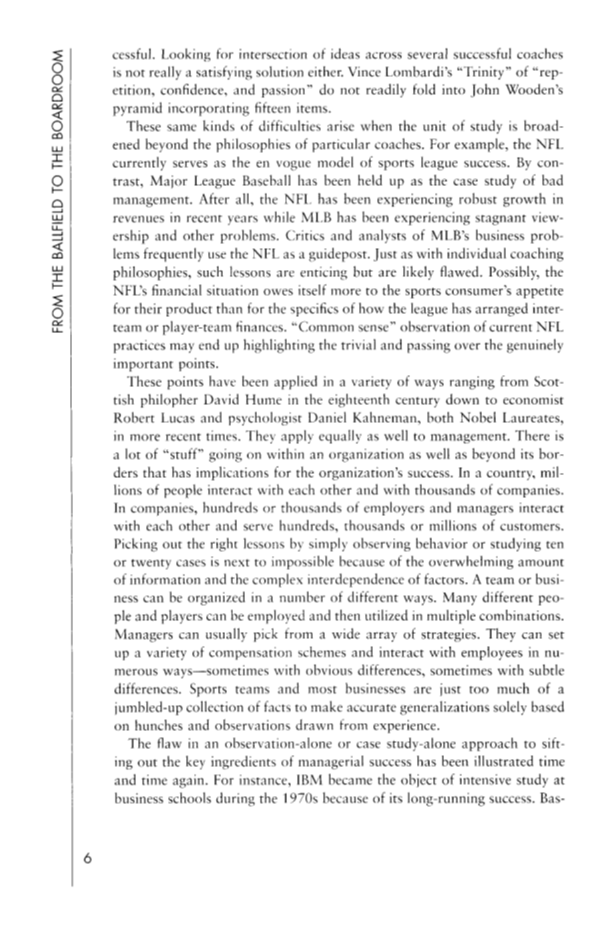cessful. Looking for intersection of ideas across several successful coaches is not really a satisfying solution either. Vince Lombardi's "Trinity" of "rep- etition, confidence, and passion" do not readily fold into John Wooden's pyramid incorporating fifteen items. These same kinds of difficulties arise when the unit of study is broad- ened beyond the philosophies of particular coaches. For example, the NFL currently serves as the en vogue model of sports league success. By con- trast, Major League Baseball has been held up as the case study of bad management. After all, the NFL has been experiencing robust growth in revenues in recent years while MLB has been experiencing stagnant view- ership and other problems. Critics and analysts of MLB's business prob- lems frequently use the NFL as a guidepost. Just as with individual coaching philosophies, such lessons are enticing but are likely flawed. Possibly, the NFL's financial situation owes itself more to the sports consumer's appetite for their product than for the specifics of how the league has arranged inter- team or player-team finances. "Common sense" observation of current NFL practices may end up highlighting the trivial and passing over the genuinely important points. These points have been applied in a variety of ways ranging from Scot- tish philopher David Hume in the eighteenth century down to economist Robert Lucas and psychologist Daniel Kahneman, both Nobel Laureates, in more recent times. They apply equally as well to management. There is a lot of "stuff" going on within an organization as well as beyond its bor- ders that has implications for the organization's success. In a country, mil- lions of people interact with each other and with thousands of companies. In companies, hundreds or thousands of employers and managers interact with each other and serve hundreds, thousands or millions of customers. Picking out the right lessons by simply observing behavior or studying ten or twenty cases is next to impossible because of the overwhelming amount of information and the complex interdependence of factors. A team or busi- ness can be organized in a number of different ways. Many different peo- ple and players can be employed and then utilized in multiple combinations. Managers can usually pick from a wide array of strategies. They can set up a variety of compensation schemes and interact with employees in nu- merous ways—sometimes with obvious differences, sometimes with subtle differences. Sports teams and most businesses are just too much of a jumbled-up collection of facts to make accurate generalizations solely based on hunches and observations drawn from experience. The flaw in an observation-alone or case study-alone approach to sift- ing out the key ingredients of managerial success has been illustrated time and time again. For instance, IBM became the object of intensive study at business schools during the 1970s because of its long-running success. Bas- 6
Document Details My Account Print multiple pages
Print
You have printed 0 times in the last 24 hours.
Your print count will reset on at .
You may print 0 more time(s) before then.
You may print a maximum of 0 pages at a time.
































































































































































































































































